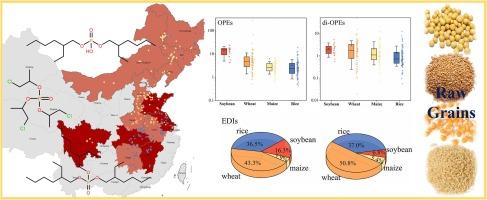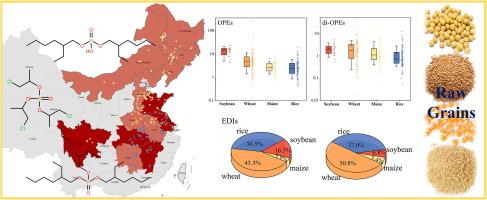中国粮食原料中有机磷酯和二酯的全国调查:分布、来源和风险评估的意义
IF 9.7
1区 环境科学与生态学
Q1 ENVIRONMENTAL SCIENCES
引用次数: 0
摘要
关于膳食暴露于有机磷酸酯(OPEs)和二磷酸酯(di-OPEs)的研究有限,特别是二磷酸酯及其在作为人类饮食基本主食的粗粮中的存在。本研究对中国13个粮食主产区的289份粮食样品(小麦、水稻、玉米和大豆4种粮食类型)进行了18种OPEs和8种双OPEs测定。三(2-氯异丙基)磷酸(TCIPP)和三(2-乙基己基)磷酸(TEHP)是主要的OPEs,二(2-乙基己基)磷酸(BEHP)是主要的OPEs。∑OPEs和∑di-OPEs浓度最高的是大豆(中位数分别为14.9和1.87 ng/g),其次是小麦(中位数分别为4.79和1.69 ng/g)、玉米(中位数分别为2.63和1.10 ng/g)和水稻(中位数分别为2.37和0.726 ng/g)。玉米和大豆中OPEs和双OPEs的区域分布较为均匀。在小麦中,四川和山东的OPEs和diopes均显著高于四川和山东,而水稻中OPEs和diopes的空间格局存在差异,表明diopes的来源不同。土壤类型、秸秆周转和农药用量对籽粒中TEHP、三(2-氯乙基)磷酸(TCEP)和三乙基磷酸(TEP)的浓度分别有显著影响。除TEHP和三(1,3-二氯-2-丙基)磷酸(TDCPP)在糙米和精米中的含量相近外,其他8种糙米中OPEs的含量仅占先前报道的精米中OPEs含量的1.9 - 36% %,表明工业加工是市场谷物中OPEs的主要来源。通过谷物摄入OPEs和di-OPEs的估计日摄入量分别为25.0 ~ 40.4 ng/kg bw/d和7.55 ~ 11.7 ng/kg bw/d,主要来自小麦和水稻,高于通过粉尘摄入和饮用水摄入,表明谷物是人类暴露的主要来源。直接从谷物中摄取的二羟基戊二烯明显高于母体二羟基戊二烯代谢产生的二羟基戊二烯,这意味着根据体内二羟基戊二烯的水平来估计二羟基戊二烯的暴露量是不准确的,需要进一步的研究。本文章由计算机程序翻译,如有差异,请以英文原文为准。


Nationwide investigation on organophosphate esters and di-esters in raw grains from China: Distribution, sources, and implications for risk assessment
Studies on dietary exposure to organophosphate esters (OPEs) and diesters (di-OPEs) are limited, especially regarding di-OPEs and their presence in raw grains, which are fundamental staples of the human diet. In this study, 18 OPEs and 8 di-OPEs were measured in 289 grain samples from 13 major grain-producing regions in China belonging to four grain types: wheat, rice, maize, and soybean. Tris(2-chloroisopropyl) phosphate (TCIPP) and tris(2-ethylhexyl) phosphate (TEHP) were the dominant OPEs, while bis(2-ethylhexyl) phosphate (BEHP) was the main di-OPE. The highest concentrations of both ∑OPEs and ∑di-OPEs were observed in soybean (median: 14.9 and 1.87 ng/g, respectively), followed by wheat (4.79 and 1.69 ng/g), maize (2.63 and 1.10 ng/g), and rice (2.37 and 0.726 ng/g). The regional distribution of OPEs and di-OPEs in maize and soybean was relatively homogeneous. In wheat, both OPEs and di-OPEs were significantly higher in Sichuan and Shandong provinces, whereas the spatial patterns of OPEs and di-OPEs in rice differed, suggesting separate sources for di-OPEs. Soil type, straw turnover, and pesticide use could significantly affect the concentrations of TEHP, tri(2-chloroethyl) phosphate (TCEP), and triethyl phosphate (TEP) in grains, respectively. Except for TEHP and tris(1,3-dichloro-2-propyl) phosphate (TDCPP), whose concentrations were similar in raw and polished rice, the other 8 OPEs in raw rice accounted for only 1.9–36 % of those in polished rice reported previously, indicating industrial processing as the main source of these OPEs in marketed grains. The estimated daily intake of OPEs and di-OPEs through grain consumption were 25.0–40.4 ng/kg bw/d and 7.55–11.7 ng/kg bw/d, respectively, primarily contributed by wheat and rice, which was higher than those through dust ingestion and drinking water, suggesting that grain is the main source of human exposure. Di-OPEs directly ingested from grains are significantly higher than those derived from the metabolism of their parent OPEs, implying that estimating OPE exposure based on internal di-OPE levels is inaccurate and warrants further research.
求助全文
通过发布文献求助,成功后即可免费获取论文全文。
去求助
来源期刊

Environment International
环境科学-环境科学
CiteScore
21.90
自引率
3.40%
发文量
734
审稿时长
2.8 months
期刊介绍:
Environmental Health publishes manuscripts focusing on critical aspects of environmental and occupational medicine, including studies in toxicology and epidemiology, to illuminate the human health implications of exposure to environmental hazards. The journal adopts an open-access model and practices open peer review.
It caters to scientists and practitioners across all environmental science domains, directly or indirectly impacting human health and well-being. With a commitment to enhancing the prevention of environmentally-related health risks, Environmental Health serves as a public health journal for the community and scientists engaged in matters of public health significance concerning the environment.
 求助内容:
求助内容: 应助结果提醒方式:
应助结果提醒方式:


